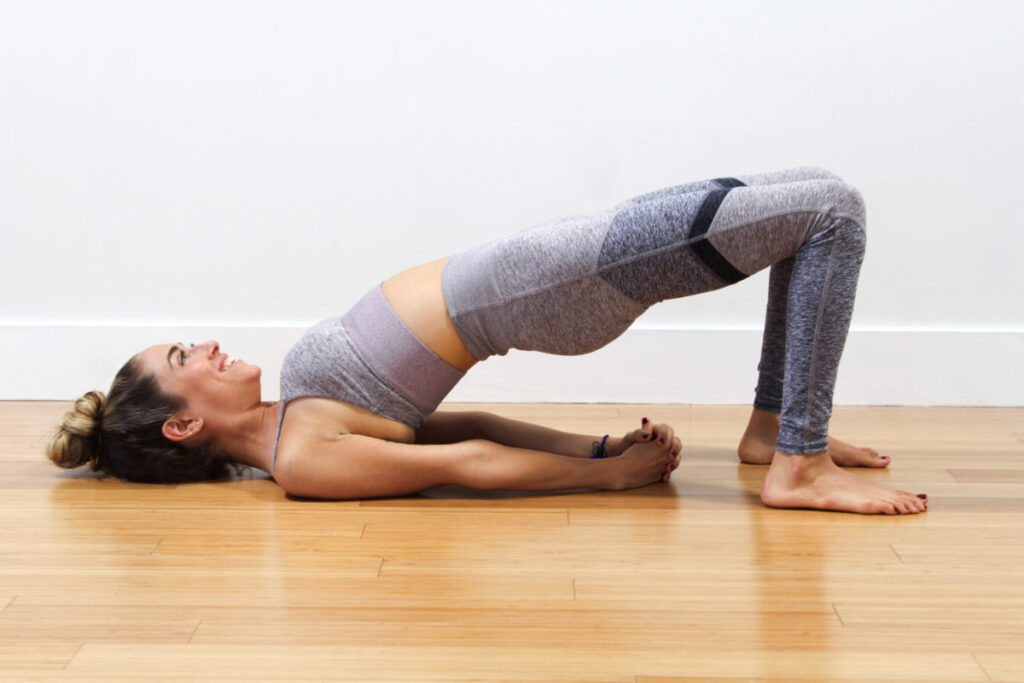
Bridge Pose, or Setu Bandhasana, is a gentle backbend that strengthens and stretches the body while promoting relaxation. Known for its uplifting and heart-opening effects, Bridge Pose engages the legs, glutes, and core while lengthening the spine. It’s an excellent pose to relieve stress, improve posture, and open up the chest and shoulders. Here’s how to perform Bridge Pose, its benefits, and some helpful tips.
How to Do Bridge Pose (Setu Bandhasana)
- Lie on Your Back: Begin by lying flat on your back, arms at your sides with your palms facing down.
- Bend Your Knees: Bend your knees and place your feet flat on the floor, hip-width apart, with your heels close to your sitting bones.
- Engage Your Feet and Legs: Press down firmly through your feet and engage your thighs to support the lift.
- Lift Your Hips: Inhale and lift your hips toward the ceiling, pressing through your feet and shoulders. Your knees should be aligned over your heels.
- Roll Your Shoulders Under: For more stability, roll your shoulders slightly under your body and clasp your hands beneath your back. Keep your chin slightly tucked.
- Engage the Glutes and Core: Engage your glutes and core to support the lower back as you lift your hips higher, reaching your chest toward your chin.
- Hold and Breathe: Stay in Bridge Pose for several deep breaths, keeping your hips lifted and your spine lengthened.
To release, exhale as you gently lower your spine back to the mat, one vertebra at a time.
Benefits of Bridge Pose (Setu Bandhasana)
- Strengthens the Glutes and Hamstrings: Lifting the hips engages the glutes and hamstrings, building strength and tone in the lower body.
- Opens the Chest and Shoulders: Bridge Pose is a gentle heart opener, expanding the chest and shoulders, which can help improve posture and release tension in the upper body.
- Stretches the Spine and Hip Flexors: The backbend stretches the spine, hip flexors, and front of the body, relieving tension in these areas.
- Calms the Mind and Reduces Stress: By focusing on the breath and stretching the chest, Bridge Pose can activate the parasympathetic nervous system, promoting relaxation and reducing stress.
- Improves Digestion and Circulation: The slight inversion and compression of the abdomen can stimulate digestion and increase circulation throughout the body.
Tips for Practicing Bridge Pose
- Use a Block for Support: If you want a more restorative version, place a yoga block under your sacrum for support, allowing you to hold the pose comfortably for a longer period.
- Engage the Inner Thighs: Squeeze your inner thighs together slightly to keep the knees from splaying out. This alignment protects the lower back and strengthens the legs.
- Avoid Overarching the Lower Back: Focus on lifting from the thighs and glutes rather than overarching the lower back. Engaging the core can help support a neutral spine.
- Relax the Jaw and Face: Keep your face and neck relaxed to avoid straining, and breathe deeply to enhance relaxation in the pose.
Bridge Pose is both energizing and calming, making it a wonderful addition to any yoga practice. By connecting the breath with movement and focusing on alignment, Setu Bandhasana encourages strength, flexibility, and a sense of grounding that leaves you feeling revitalized and refreshed.